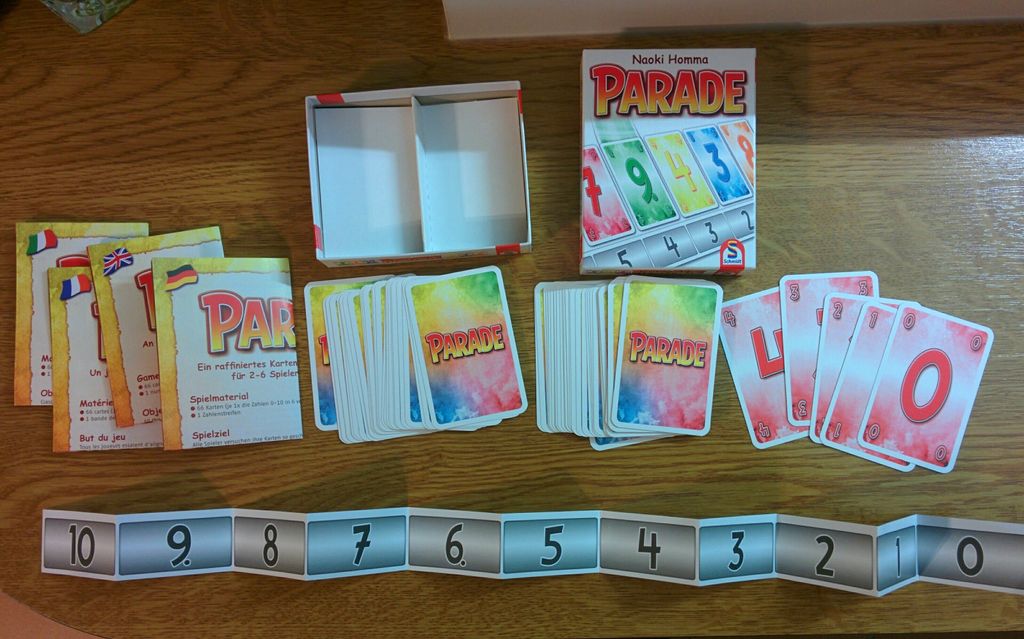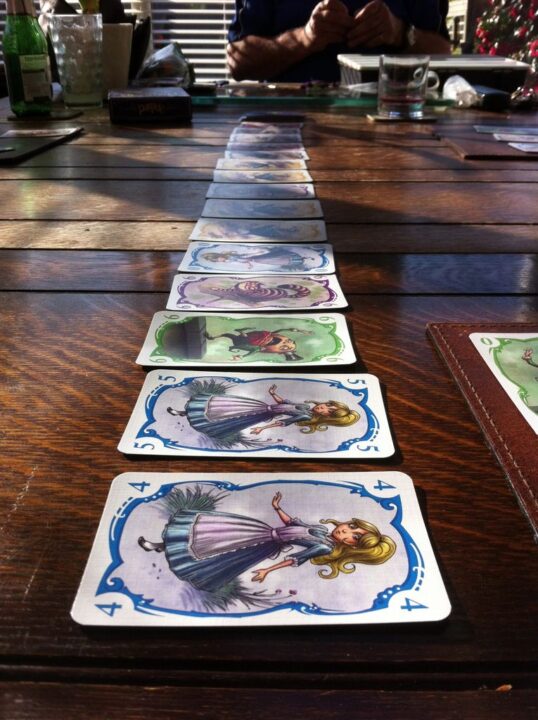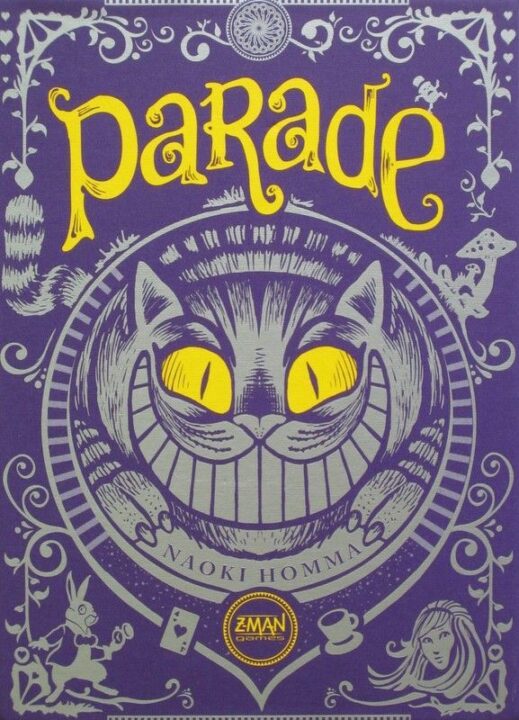Welcome to my review of Parade! If you ever wondered what it’s like to form a fancy line of Alice in Wonderland characters while doing math in your head and plotting your friends’ downfall, well, let me tell you, this game has you covered. My friends and I gathered around the kitchen table (armed with snacks and a suspicious amount of overconfidence) and put this sneaky little card game through its paces. Was it pure magic or just another pretty box on the shelf? Let’s find out if this parade is worth joining!
How It Plays
Setting up
First, shuffle the cards and give each player a hand of five cards. Lay out six cards in a line in the center. This is the parade. Set the rest of the deck face down. Hope your dog doesn’t eat any cards, like mine almost did last game night.
Gameplay
On your turn, play one card from your hand to the end of the parade. You then count out a number of cards from the front of the parade equal to the number on the card you played—those stay put. Now check every remaining card after that. If they match your card’s color or the number is less than or equal to yours, you have to pick them up. You then draw a new card. Parade is a bit like trying to avoid being last in line at the DMV, but with more smiling and less paperwork.
Winning the game
The game ends when either all cards are played or someone collects all six colors. Add up the values of all the cards you collected, unless you have the most of a color (then each of those cards are only worth one point). The person with the lowest score wins. So yes, for once, it pays to be unpopular.
Want to know more? Read our extensive strategy guide for Parade.
Rules and Learning Curve in Parade: Quick to Grasp, Tricky to Master
Alright, let’s talk rules! Parade comes in a small box, and thank goodness, the rulebook matches. You won’t need a law degree or a magnifying glass to get through the instructions. I brought Parade to game night last Friday, and my friends—an odd mix of tired parents and caffeine-fueled students—picked it up in less than ten minutes. No one threw the rules across the room, so that’s a win.
The basics are simple: play a card from your hand to the parade line, then collect—or if you’re lucky, avoid collecting—cards depending on what you put down. The colors and numbers are easy to learn, and the scoring system only twisted my brain a little bit the first round. There’s a quirky twist, though: you don’t always want the lowest score, you want the fewest matching colors, which always trips up that one friend who plays games like it’s a game of golf. Honestly, the only bit that might confuse newbies is the way you ‘collect’ cards after placing your card, but after two turns, it just clicks.
Parade’s rules feel fair and streamlined. Nobody at the table was left scratching their heads—or flipping the table in rage. There’s even a quick reference card, perfect for people who forget stuff (like me). If you’re looking for a game you can teach anyone in no time, Parade does a great job.
But let’s not rest on our laurels—next, I’ll spill all the tea on player interaction and the sneaky strategic plays hiding beneath those pretty Alice in Wonderland cards.

Parade: Players, Plots, and Trickery
One thing I noticed right away with Parade is that players can’t coast along on autopilot. You need to watch everything. In Parade, every turn is a little showdown of cunning and prediction. The game may look polite with all those Alice-in-Wonderland folks on the cards, but don’t let the happy colors fool you. You’ll spend a lot of time thinking about what cards your friends might drop and which row they’ll end up wrecking next. Seriously, I have never seen so many smiles hiding so much evil.
Player interaction sits at the heart of Parade. It’s not just about lowering your own score—it’s about bumping up your friends’ points (preferably off a cliff). I remember Dave once picked up a whole row of cards from me just because I looked too happy. There’s definitely some good-natured sabotage built into this game, which I love. Every time you think you’ve got it all under control, someone else zigs instead of zags and your whole parade goes off the rails. Nobody is ever out of the game, since the mood can flip in one round.
Strategy in Parade is all about risk and timing. You need to decide when to dump high cards, when to take a hit, and sometimes when to just let chaos reign. There’s a great balance between calculated moves and reading your fellow players. It’s never just random luck, either. Outthinking your pals brings the real joy—and sometimes the real heartbreak. Next up, I’ll tell you if Parade’s art and bits make you want to frame them or fling them across the room!

Art and Component Quality: Parade’s Whimsical Wonderland
The first thing that smacked me in the eyes with Parade was the artwork. I don’t mean a light tap. I mean a full cartoon slapstick pie-in-the-face. Bright, bold Alice in Wonderland vibes take over every card, and the colors pop harder than a kid’s birthday balloon. The characters look like they leapt out of a storybook looking for tea and maybe a little trouble.
The cards feel slick but sturdy, and survived a few of my friends’ greasy chip fingers with no tragic casualties. (Pro tip: parade and snacks mix well, but maybe wipe your hands first, just saying). The backs of the cards make the parade line look like a real, loopy procession—little details like that never fail to get a nod from me and my game group.
The box itself is slim and travel-friendly, perfect for tossing in a backpack or balancing on a wobbly coffee shop table. There are no fiddly extras—just a deck of cards and a handful of scoring tokens. Some folks might wish for more bells and whistles, but I liked the focus on keeping things simple and uncluttered. Less setup, more time for actual fun (and a bit of harmless scheming).
One thing to mention: if you’re the sort who brings games to every social event, the cards did start to show a little wear after a dozen plays. Still, nothing that a good card sleeve can’t fix!
But can lovely artwork and sturdy bits save you from bad luck? Strap in, because up next is the great parade of luck versus skill!
Luck vs Skill in Parade: Who’s Really in Control?
Let me get right to it—when it comes to Parade, you won’t be at the mercy of your lucky socks. This is not one of those games where you win because you channeled the spirit of a leprechaun or found a four-leaf clover in your cereal. Nope, in Parade, what you do matters more than what cards you draw.
Every turn, you’re handed a choice: which character card do you add to the parade? Sounds simple, right? But—here’s where you get to show off your big brain—every play can mess with your opponents, help yourself, or do both. You have to watch what everyone else is collecting, try not to wear your poker face upside-down, and figure out which card hurts you the least (or them the most).
Sure, you can’t predict every single card. Sometimes your hand looks like it was designed by a prankster. But, good players have lots of room to outmaneuver the others. The choices you make, the parades you create (or crash), and the timing of your moves all weigh heavier than raw luck. You won’t see someone win Parade just because they stumbled into a perfect draw. Honestly, if you lose, you probably outsmarted yourself, and if you win, you get bragging rights for legit outfoxing your friends.
So, is Parade fair? You bet. Skill wins more games than luck, which I always appreciate. If you want a game where decisions matter and the winner outthinks, not out-lucks, the rest, I totally recommend Parade. Just remember, your friends will remember your clever plays—and your sneaky betrayals—for a long, long time.
Conclusion
Alright folks, that wraps up my colorful journey with Parade. If you like a game that looks good, plays fast, and lets you outwit your friends without flipping tables, Parade is a winner. The rules are clear, the art is charming, and you actually feel smart when you sneak a win. There’s some luck, but the game rewards skill and paying attention. Watch out though—after a dozen plays, the cards in my set started to show their age. If you’re careful, they’ll last, unless your friends are card-mangling monsters. If you want a clever, thinky filler with just the right dose of mischief, grab Parade. This is Jamie, signing off and putting away my hat made of playing cards—this concludes my review!


